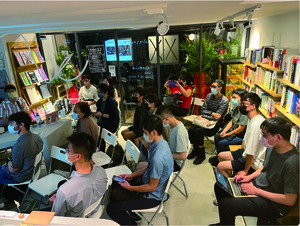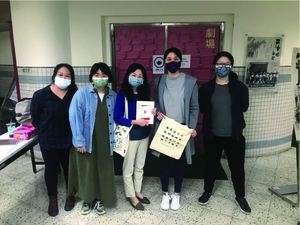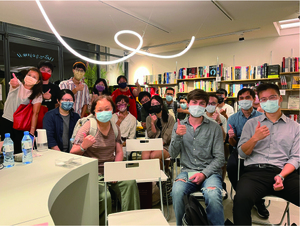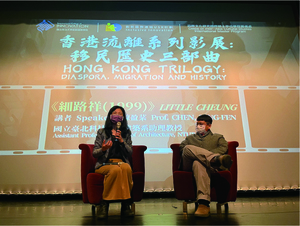Understanding Hong Kong through Cinema: Serial Screenings in NCCU Brought Attention to the Diaspora and Migration of the City




Date :
2022-06-22
Department :
International College of Innovation
【Article by International College of Innovation】
Many in Taiwan have known about the Anti-Extradition Law Amendment Bill Movement in Hong Kong since June 2019, but there might not be as many people who did understand the context. To provide its students with better knowledge of the evolution of Hong Kong-China relations and the construction of Hong Kong identity, the International College of Innovation of National Chengchi University (NCCU) and the Inclusive Innovation USR Project had held Hong Kong Trilogy: Diaspora, Migration, and History from late April to mid-May. The event included lectures and screenings of three films: The Kid (1950), Little Cheung (1999), and My Prince Edward (2019). The serial screening had attracted not only members on campus, but also Hongkongers in Taiwan and local movie-goers who are interested in the topic.
The Kid (1950), directed by Fung Fung, portrays the life of 10-year-old boy Little Cheung, whose family had just immigrated to Hong Kong from China and were suffering from poverty and an uncertain future. The protagonist was played by Hong Kong action film icon Bruce Lee, who was just around 10 years old at that time. In the post-screening Q&A session, Hong Kong culture observe writer Dr. Chan, Ka Ming mentioned that from the 1940s to the 1960s, those who fled from mainland China to Hong Kong generally did not have the conception of staying in the city for a long time. It was also around the same time that the economic development in Hong Kong started to rise. With these two elements combined, in cinema, filmmakers coming from the mainland, especially the "leftist" filmmakers, tended to depict the negative side of Hong Kong, a representative of capitalism, and end the film with scenarios like “heading back to the countryside,” usually meaning going back to China. “They might not tell the best story, but the point was to criticize capitalism through their work,” Chan explained, “Although some plots in The Kid did not make sense at all, the film illustrated a rather amicable relationship of people.”
Unlike other sessions, the screening of The Kid was conducted in the recently opened Nowhere Bookstore in Ximending, instead of the Communication Building Theatre on campus. The Chinese name of Nowhere Bookstore stands for “enclave” or “exclave” in geography, which further makes itself a representation of the global diaspora and immigration of Hongkongers in recent years. Although some could not attend the event due to the change of venue, it allowed new audience near the bookstore to come and join the post-screening discussion.
The second film of the series was Hong Kong director Fruit Chan's award-winning film Little Cheung (1999). Although it shares the same Chinese name as the previous film, and also contains a protagonist named Little Cheung, it dealt with the identity crisis among people in Hong Kong around the 1990s, which was close to the city’s handover to China in July 1997. In the post-screening Q&A session, Chen, Ying-fen, assistant professor in the Dept. of Architecture, National Taipei University of Technology (NTUT), pointed out that now is a good time to rewatch this film, especially after the 2019 protest. As a zealous fan of Hong Kong cinema who has stayed there for a while, Chen described that the streets and scenes that are shown in the film look “quite the same but not the same” comparing to nowadays Hong Kong. For instance, in a scene that had numerous banners of shops in the background, one of those banners read “Hong Kong Confederation of Trade Unions (HKCTU),” a labor union that was forced into dissolution in October 2021 due to the political pressure under Hong Kong national security law.
Meanwhile, Chen suggested that the public image of Hong Kong police around the time of the film and now are worth comparing. In Little Cheung, the police showed up several times to bring in the undocumented immigrants, and one of the main characters is eventually captured. Chen stated that although the police force in Hong Kong serves different regimes before and after July 1997, it is still quite the same from the core: a faceless group of people that serves as the extension of the government. Considering the context of the recent protest, Chen asked the audience of the screening to think about “Where would all these characters be in 2019? Which side would they take during the Movement?”
The last film, My Prince Edward (2019) by Norris Wong, is the most recent in the trilogy. As Wong's directorial debut, it blended the pressure of marriage, gender issue, and Hong Kong-China relations in a loving couple that is trying to get married. Wong herself said at the post-screening Q&A session that she used to live across Golden Plaza, Hong Kong's famous wedding-themed shopping mall, and also where the story took place. Not only the idea but also the Chinese name of the film is derived from the place. “Many advised me to change that,” Wong recalled, “but I couldn't come up with a better name. And I kind of want to let the foreign audience know about the place, just like what Wong Kar-wai did in Chungking Express (1994).”
The film was made with a budget of 3.25 million HKD (about 10 million NTD), all coming from the funding of the First Feature Film Initiative of the Hong Kong government. Under a tight budget, Wong admitted that there were still some improvements that could be made in the film. The director further mentioned the predicaments Hong Kong filmmakers have been facing under the current political atmosphere, which made freely expressing oneself even more challenging. “We the filmmakers can hardly know about the redlines of censorship in advance. We are still in the stage of trial-and-error.” She analyzed that if My Prince Edward was made a few years later, it could still be able to get funding from the government, but might not be able to be shown in Hong Kong commercial cinema since its story could be too sensitive to the government's point of view. “I think for me, after the national security law, I might go for indie,” Wong explained, “the point is to tell the story you want to tell in a way that you feel comfortable.”
Since the film conveyed the hardship that Hongkongers face in a relatively lighthearted and sometimes humorous tone, ICI faculty member Professor Tzu-chi Ou concluded that the film reminded her “there are more than politics when it comes to Hong Kong.” By understanding how Hong Kong has come to its position today, one can be more likely to view the city with a more diverse perspective.
Many in Taiwan have known about the Anti-Extradition Law Amendment Bill Movement in Hong Kong since June 2019, but there might not be as many people who did understand the context. To provide its students with better knowledge of the evolution of Hong Kong-China relations and the construction of Hong Kong identity, the International College of Innovation of National Chengchi University (NCCU) and the Inclusive Innovation USR Project had held Hong Kong Trilogy: Diaspora, Migration, and History from late April to mid-May. The event included lectures and screenings of three films: The Kid (1950), Little Cheung (1999), and My Prince Edward (2019). The serial screening had attracted not only members on campus, but also Hongkongers in Taiwan and local movie-goers who are interested in the topic.
The Kid (1950), directed by Fung Fung, portrays the life of 10-year-old boy Little Cheung, whose family had just immigrated to Hong Kong from China and were suffering from poverty and an uncertain future. The protagonist was played by Hong Kong action film icon Bruce Lee, who was just around 10 years old at that time. In the post-screening Q&A session, Hong Kong culture observe writer Dr. Chan, Ka Ming mentioned that from the 1940s to the 1960s, those who fled from mainland China to Hong Kong generally did not have the conception of staying in the city for a long time. It was also around the same time that the economic development in Hong Kong started to rise. With these two elements combined, in cinema, filmmakers coming from the mainland, especially the "leftist" filmmakers, tended to depict the negative side of Hong Kong, a representative of capitalism, and end the film with scenarios like “heading back to the countryside,” usually meaning going back to China. “They might not tell the best story, but the point was to criticize capitalism through their work,” Chan explained, “Although some plots in The Kid did not make sense at all, the film illustrated a rather amicable relationship of people.”
Unlike other sessions, the screening of The Kid was conducted in the recently opened Nowhere Bookstore in Ximending, instead of the Communication Building Theatre on campus. The Chinese name of Nowhere Bookstore stands for “enclave” or “exclave” in geography, which further makes itself a representation of the global diaspora and immigration of Hongkongers in recent years. Although some could not attend the event due to the change of venue, it allowed new audience near the bookstore to come and join the post-screening discussion.
The second film of the series was Hong Kong director Fruit Chan's award-winning film Little Cheung (1999). Although it shares the same Chinese name as the previous film, and also contains a protagonist named Little Cheung, it dealt with the identity crisis among people in Hong Kong around the 1990s, which was close to the city’s handover to China in July 1997. In the post-screening Q&A session, Chen, Ying-fen, assistant professor in the Dept. of Architecture, National Taipei University of Technology (NTUT), pointed out that now is a good time to rewatch this film, especially after the 2019 protest. As a zealous fan of Hong Kong cinema who has stayed there for a while, Chen described that the streets and scenes that are shown in the film look “quite the same but not the same” comparing to nowadays Hong Kong. For instance, in a scene that had numerous banners of shops in the background, one of those banners read “Hong Kong Confederation of Trade Unions (HKCTU),” a labor union that was forced into dissolution in October 2021 due to the political pressure under Hong Kong national security law.
Meanwhile, Chen suggested that the public image of Hong Kong police around the time of the film and now are worth comparing. In Little Cheung, the police showed up several times to bring in the undocumented immigrants, and one of the main characters is eventually captured. Chen stated that although the police force in Hong Kong serves different regimes before and after July 1997, it is still quite the same from the core: a faceless group of people that serves as the extension of the government. Considering the context of the recent protest, Chen asked the audience of the screening to think about “Where would all these characters be in 2019? Which side would they take during the Movement?”
The last film, My Prince Edward (2019) by Norris Wong, is the most recent in the trilogy. As Wong's directorial debut, it blended the pressure of marriage, gender issue, and Hong Kong-China relations in a loving couple that is trying to get married. Wong herself said at the post-screening Q&A session that she used to live across Golden Plaza, Hong Kong's famous wedding-themed shopping mall, and also where the story took place. Not only the idea but also the Chinese name of the film is derived from the place. “Many advised me to change that,” Wong recalled, “but I couldn't come up with a better name. And I kind of want to let the foreign audience know about the place, just like what Wong Kar-wai did in Chungking Express (1994).”
The film was made with a budget of 3.25 million HKD (about 10 million NTD), all coming from the funding of the First Feature Film Initiative of the Hong Kong government. Under a tight budget, Wong admitted that there were still some improvements that could be made in the film. The director further mentioned the predicaments Hong Kong filmmakers have been facing under the current political atmosphere, which made freely expressing oneself even more challenging. “We the filmmakers can hardly know about the redlines of censorship in advance. We are still in the stage of trial-and-error.” She analyzed that if My Prince Edward was made a few years later, it could still be able to get funding from the government, but might not be able to be shown in Hong Kong commercial cinema since its story could be too sensitive to the government's point of view. “I think for me, after the national security law, I might go for indie,” Wong explained, “the point is to tell the story you want to tell in a way that you feel comfortable.”
Since the film conveyed the hardship that Hongkongers face in a relatively lighthearted and sometimes humorous tone, ICI faculty member Professor Tzu-chi Ou concluded that the film reminded her “there are more than politics when it comes to Hong Kong.” By understanding how Hong Kong has come to its position today, one can be more likely to view the city with a more diverse perspective.


 Fax:886-2-29379611
Fax:886-2-29379611